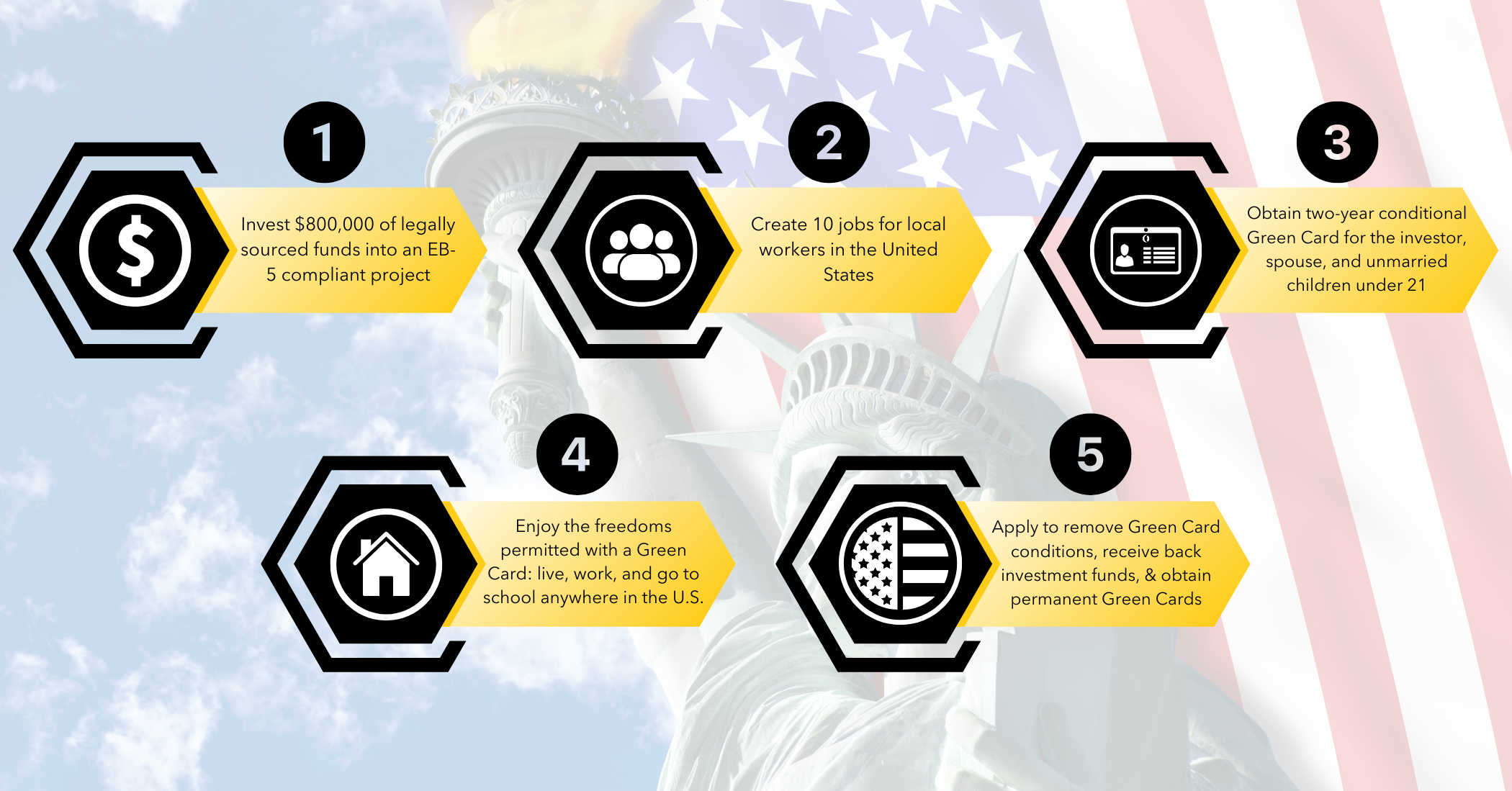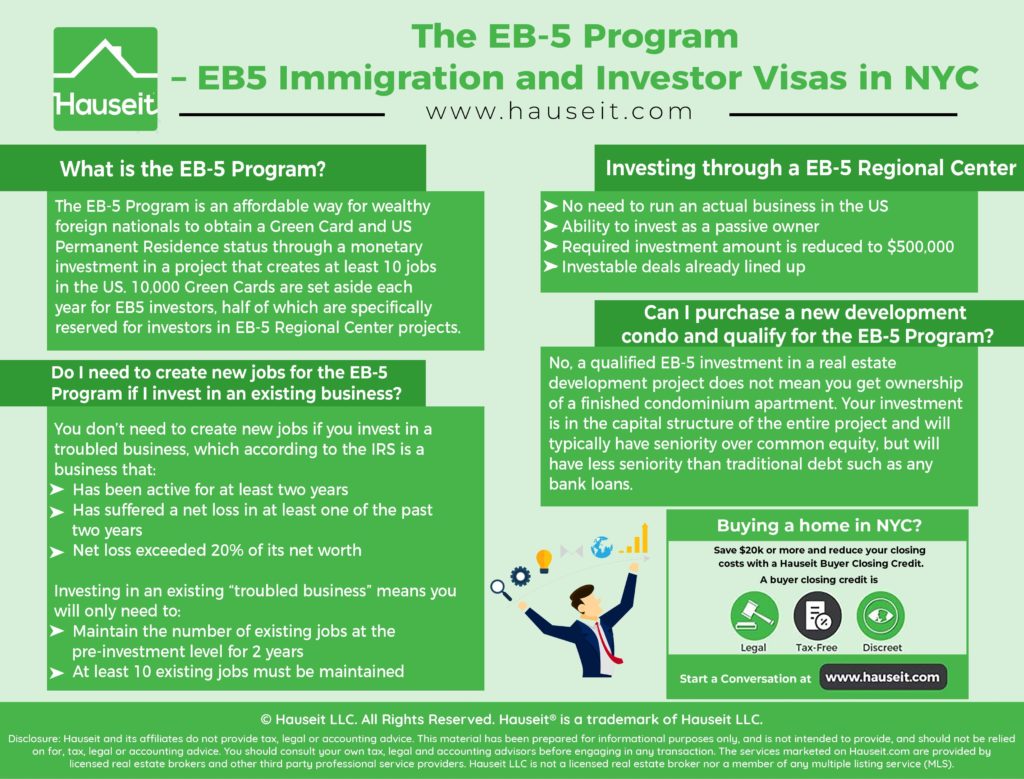Open Your Visa: The Ultimate Guide to the EB-5 Visa Investment Program
The EB-5 Visa Investment Program supplies a distinct pathway to U.S. irreversible residency for international financiers, cultivating economic development through job creation. Recognizing the intricacies of this program is necessary for possible candidates, as it includes particular eligibility needs and varying investment quantities. This guide aims to light up the key components of the EB-5 process, from passing through local facilities to reviewing possible threats and rewards. Lots of capitalists may neglect vital details that could considerably affect their application. What are the typical risks that could threaten your financial investment trip?
What Is the EB-5 Visa?
Understanding the EB-5 Visa is crucial for international financiers seeking long-term residency in the USA. Developed by the Immigration Act of 1990, the EB-5 Visa program provides a path to authorized long-term residency for people who buy a united state company. This program is especially appealing as it allows capitalists and their prompt relative-- partners and unmarried children under 21-- to obtain Visa, facilitating their transfer to the united state
To receive the EB-5 Visa, capitalists have to make a minimal financial investment in a new or existing business. This investment has to produce or protect at the very least ten permanent work for united state employees. The investment can be made straight in an organization or through a designated Regional Facility, which is an organization accepted by U.S. Citizenship and Immigration Provider (USCIS) to promote economic growth through work development.
The EB-5 program is designed not only to draw in foreign resources yet also to stimulate financial growth and task production in the United States. Given its prospective benefits, recognizing the subtleties of the EB-5 Visa is essential for investors aiming to navigate the intricacies of U.S. migration law successfully.
Qualification Needs
To successfully acquire an EB-5 Visa, candidates should fulfill particular qualification needs set forth by united state Citizenship and Immigration Solutions (USCIS) The applicant should be an international nationwide that shows the capability to spend in a brand-new business enterprise - EB-5 Investment Amount. This venture must be established after November 29, 1990, or be a distressed venture that has experienced significant losses

It is additionally necessary that applicants verify the lawful resource of their investment funds, making certain that the cash was acquired via legal ways. Candidates must show their intent to reside in the United States and actively take part in the monitoring of the enterprise, whether directly or indirectly. Satisfying these qualification requirements is crucial for an effective EB-5 Visa, leading the way for eventual permanent residency.
Investment Quantities
When thinking about the EB-5 Visa program, possible capitalists must understand the particular investment quantities required, which are vital to the application process. The common investment quantity is currently evaluated $1 million. This figure is substantially reduced to $500,000 if the investment is made in a targeted work location (TEA) TEAs are defined as backwoods or areas experiencing high unemployment, giving an one-of-a-kind possibility for capitalists to add to economically distressed communities while additionally satisfying visa requirements.
It is important for capitalists to recognize that these quantities go through transform, as they are periodically assessed by the U.S. Citizenship and Migration Solutions (USCIS) Additionally, the investment must be made in a new business that creates or preserves at the very least 10 full time work for qualifying U.S. employees within 2 years of the financier's admission to the USA.
Choosing the appropriate investment chance is essential, as it not just impacts the likelihood of successful visa approval yet likewise the capitalist's monetary returns. Therefore, extensive research and due persistance are crucial before dedicating to any kind of investment under the EB-5 program.
Application Process
The application process for the EB-5 Visa Investment Program involves numerous important actions that guarantee conformity with qualification demands. Recognizing these demands is important for prospective applicants to browse the process successfully. This section outlines the essential steps to efficiently submit an EB-5 application.
Eligibility Requirements Discussed
Comprehending the eligibility demands for the EB-5 Visa investment program is important for potential investors, as these standards frequently identify the success of their application. The EB-5 Visa is designed for international nationals looking for long-term residency in the United States with financial investment in a new company.
To certify, applicants have to invest a minimum of $1 million, or $500,000 in targeted work locations (TEAs), which are defined as country or high-unemployment regions. The financial investment has to maintain or develop a minimum of ten permanent work for qualifying united state workers within 2 years of the capitalist's admission to the U.S. as a conditional irreversible resident.

It is necessary for possible capitalists to thoroughly analyze their qualification and talk to immigration experts to navigate the complexities of the EB-5 Visa program properly, making certain compliance with all guidelines and optimizing their opportunities for authorization.
Step-by-Step Application Process
Steering the application process for the EB-5 Visa investment program needs mindful preparation and interest to detail. The trip begins with picking an ideal investment possibility, ideally with a Regional Center, to guarantee conformity with program requirements. Conduct detailed due persistance to analyze the project's viability and job development capacity.
When you have actually made your financial investment, the following step is to prepare Form I-526, Immigrant Petition by Alien Investor. This type needs sustaining documents, consisting of proof of your mutual fund' legal resource and a comprehensive organization strategy outlining work production metrics.
After the USCIS processes Form I-526 and authorizes it, you can move on with either readjusting your standing if already in the U (EB-5).S. or making an application for an immigrant visa at a united state consular office abroad. You will certainly need to send Type DS-260, Immigrant Visa and Alien Registration Application, along with medical exams and various other needed documents
Regional Centers vs. Direct Investment

Regional facilities are marked organizations that handle particular EB-5 financial investment tasks. They frequently merge funds from multiple investors to fund larger jobs, such as realty developments or infrastructure initiatives. This option generally permits investors to take advantage of an extra passive investment method, as regional centers manage job management and job creation needs on behalf of the capitalists.
On the other hand, straight investment entails the capitalist proactively handling a current or brand-new organization, therefore directly regulating their investment. This course may interest those with business experience or a need to involve closely with their company operations. Nonetheless, it needs an extra hands-on strategy, including conference certain work creation standards directly connected to the investor's business.
Eventually, the choice in between regional centers and direct investment depends upon a financier's financial goals, threat tolerance, and participation level in the business endeavor. Cautious factor to consider of these elements is important for an effective EB-5 investment experience.
Potential Dangers and Benefits
Spending via the EB-5 Visa program provides both significant opportunities and intrinsic threats that prospective capitalists have to thoroughly assess. Secret considerations include the monetary effects of the financial investment, difficulties associated with the immigration procedure, and the prospective effect of market volatility on task results. Understanding these factors is important for making informed choices that straighten with private objectives and circumstances.
Financial Investment Considerations
Maneuvering the landscape of the EB-5 Visa Investment Program needs a thorough understanding of prospective economic risks and benefits related to this special possibility. Financiers have to thoroughly consider the benefits of getting long-term residency in the United States against the economic commitments involved.
One of the key benefits of the EB-5 program is the possible roi, which can differ considerably depending on the job picked. Well-structured financial investments can generate considerable earnings while helping to create work for U.S. employees. Furthermore, effective engagement in the program can cause a path for member of the family to get residency, including in the program's charm.
Alternatively, financial dangers are inherent in any type of financial investment. The success of the task may depend upon numerous factors such as market conditions, administration skills, and regulatory changes. Capitalists may face the opportunity of losing their resources if the job fails to satisfy its goals. Furthermore, the need of keeping the investment for a details duration can present liquidity challenges.
Eventually, extensive due persistance and a clear understanding of both monetary threats and rewards are vital for prospective EB-5 financiers intending to safeguard their visa through this financial investment pathway.
Migration Process Obstacles
Although the EB-5 Visa Investment Program supplies a path to permanent residency, guiding via the migration procedure offers its very own collection of obstacles that potential investors have to thoroughly consider. One considerable difficulty includes the extensive documentation needed to validate the legitimacy of the investment. Investors need to supply detailed financial documents, source of funds, and proof showing work production, which can be both lengthy and complex.
The United State Citizenship and Immigration Provider (USCIS) has rigorous criteria for approving EB-5 applications. Any disparities in paperwork or failing to fulfill the requirements can result in delays or rejections, placing the financier's residency strategies in danger. Furthermore, the processing times for EB-5 applications can be prolonged, often expanding beyond a year, which can generate uncertainty and stress for applicants.
Another difficulty is the advancing nature of immigration regulations and policies, which can impact qualification and authorization prices. Keeping up with these changes is crucial, as they might present brand-new obstacles or change existing pathways. Despite these difficulties, effective navigation of the immigration process can result in the satisfying result of obtaining a Permit and the associated benefits of long-term residency in the United States.
Market Volatility Effect
Steering the landscape of the EB-5 Visa Investment Program needs an this acute understanding of market volatility, which can considerably affect both the threats and incentives connected with foreign financial investment - EB-5 Visa by Investment. Market variations can affect the success of projects backed by EB-5 financial investments, leading to varying end results for investors
On one hand, favorable market conditions can enhance project feasibility, leading to significant returns and a quicker course to long-term residency. On the other hand, adverse market fads may jeopardize task conclusion, decreasing the possibility of an effective financial investment and potentially bring about economic losses.
Capitalists should perform detailed due diligence to analyze the economic stability and growth potential of the projects they consider. Evaluating market fads, regional economic problems, and the track record of the job programmers can mitigate risks related to volatility. In addition, branching out investments across several tasks might supply a buffer versus possible recessions.
Inevitably, recognizing market dynamics is crucial for EB-5 investors. While the prospective incentives can be considerable, the coming with threats require a well-informed method to financial investment choices within this program. Mindful planning and tactical investment can reveal the path to both monetary gain and united state residency.
Success Stories and Testimonials
The EB-5 Visa Investment Program has changed the lives of plenty of people and households, offering them with chances to achieve their American Desire. Numerous participants have shared inspiring statements regarding their trips through the program, highlighting both the difficulties and rewards they ran into along the road.
For instance, the Nguyen household from Vietnam successfully navigated the EB-5 process, enabling them to relocate to the United States. They highlighted exactly how the program not only provided them with a pathway to long-term residency however additionally enabled them to purchase a thriving neighborhood business, developing jobs and contributing to their new neighborhood. Their story mirrors the program's dual influence on both the capitalist and the economy.
A business owner from China recounted how the EB-5 program promoted his need to broaden his tech startup in the United state By safeguarding funding through the financial investment needs, he was able to bring cutting-edge items to market while all at once securing his family members's future in America.
These testimonials illustrate the extensive impact of the EB-5 Visa Investment Program, showcasing just how it empowers people to pursue new possibilities and attain long lasting success in their brand-new homeland.
Frequently Asked Inquiries
The length of time Does the EB-5 Visa Process Commonly Take?
The EB-5 visa procedure typically takes 18 to 24 months from application entry to authorization. Processing times may vary based on individual conditions, USCIS work, and local center task specifics, potentially expanding the timeline.
Can Family Members Members Apply With the Key Financier?
Yes, relative can use along with the main investor under the EB-5 visa program. Immediate relatives, including partners and unmarried kids under 21, are qualified for acquired visas, facilitating their residency in the USA.
What Takes place if My Investment Fails?
It might endanger your migration condition if your financial investment stops working. The United State Citizenship and Migration Services calls for proof of investment and task production; failing to fulfill these requirements can cause visa rejection or revocation
Exist Age Restrictions for EB-5 Candidates?
There are no particular age constraints for EB-5 applicants. All candidates, regardless of age, must meet the program's financial investment demands and demonstrate the capability to maintain the financial investment within the designated duration.
Can I Preserve My International Citizenship While Holding an EB-5 Visa?
Yes, individuals holding an EB-5 visa can maintain their international citizenship. The EB-5 visa does not call for applicants to renounce their initial citizenship, allowing dual citizenship status, subject to the regulations of their home nation.
The EB-5 Visa Investment Program uses a distinct pathway to United state irreversible residency for international investors, promoting economic development via job production. Recognizing the qualification needs for the EB-5 Visa investment program is important for potential investors, as these criteria regularly identify the success of their application. In comparison, direct financial investment entails the capitalist proactively taking care of a new or existing company, thus straight controlling their investment. The EB-5 Visa Investment Program provides a pathway to permanent residency, steering through the immigration process presents its very own collection of obstacles that potential investors must thoroughly consider. Maneuvering the landscape of the EB-5 Visa Investment Program requires an acute recognition of market volatility, which can greatly influence both the rewards and threats associated with international financial investment.